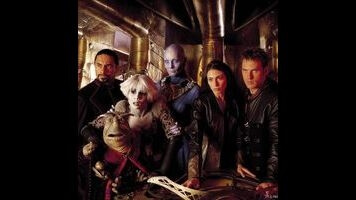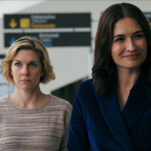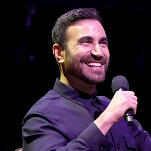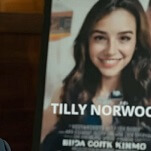“I, E.T.” (season 1, episode 2; originally aired 5/7/1999)
(Available on Hulu and Amazon Instant Video.)
“You've learned that you're not alone in the universe. That interstellar space travel's possible. That a zillion of your empirical facts about science, religion are wrong, or completely suspect. I do understand. I'm not exactly what you expected, am I?”
Just about all the great ‘90s-era space operas take a while to get going; indeed, Star Trek: The Next Generation and Babylon 5 both take as much as a season or more to really find their footing. Farscape doesn’t take nearly so long to figure itself out, and its lowlights aren’t even close to as bad as those shows’ early clunkers (with one infamous exception, but we’ll get to that in a few weeks). Farscape’s big challenge is that it has built a vast, entirely alien universe in which its stories will take place, but that means the show has to discover what stories work in this strange setting and what stories don’t. “I, E.T.” generally falls into the latter category, although it does greatly benefit from the show’s big early trump card—from the outset, both the writers and actors have a clear grasp of the central characters, and it’s primarily their interactions that elevate a mediocre narrative.
The episode is built around the Paddac beacon, a bit of Peacekeeper technology that, now that Moya’ s control collar has been removed, broadcasts the ship’s location to any nearby patrols. The beacon serves as an effective reminder of the crew’s fugitive status, how even in the Uncharted Territories they must remain constantly on their guard. The placement of the device in Moya’s neural nexus also helps illustrate the idea that this is a living ship—the beacon’s removal is spoken of as an operation, a delicate one that requires anesthetic and might kill the Leviathan. Crichton’s suggestion to land Moya in the swamp of an inhabited but primitive planet is also discussed in anthropomorphized terms, as Pilot mentions how young Leviathans sometimes play in a planet’s gravity and later describes how Moya is “frightened” once she lands in the swamp. While it’s mentioned in “Premiere” that Moya is alive, it’s not until “I, E.T.” that Farscape really has enough time to illustrate just what that means. This is arguably one of the advantages of the episode’s relatively thin story; a more dynamic story likely wouldn’t have left enough time for the show to fully establish Moya as a character in her own right. By episode’s end, a living ship has gone from bizarre to natural, and that audience understanding opens the door for stories that are more uniquely Farscape down the road.
And honestly, that current lack of distinctiveness is part of the problem with “I, E.T.”—once Crichton heads out to the planet in search of the Leviathan anesthetic clorium, the episode feels like a bad Star Trek impression. Some of that is down to more superficial elements. Farscape generally relies on body paint and makeup as opposed to face prosthetics for its humanoid aliens, and the Deneans, distinguished from humans only by their elongated ears and oversized cheeks, look like they would be more at home popping up in a random Next Generation or Voyager episode. It probably doesn’t help that the Deneans, following the lead of the episode’s main guest star Mary Mara as Lyneea, all speak with (mostly fake) American accents rather than the Australian accents that are much more typical of the Farscape universe. Since it’s only the second episode (or sixth, depending on which viewing order you use), it’s not really fair to call this a violation of the show’s aesthetics, but hanging out in an Earth-like farmhouse with a bunch of basically humanoid aliens definitely looks and feels like a letdown after the alien vistas and bold designs that characterized “Premiere.”
But then, there is a certain level of calculation here, as the Deneans and their planet are specifically meant to remind Crichton of Earth, and so their physical and vocal resemblance to him is crucial to their narrative function. When Lyneea asks Crichton whether he could possibly understand what it’s like to make first contact with aliens, he replies with the speech up above, which allows the show to explore how its protagonist is reacting to incomprehensible events unfolding around him. It’s a neat storytelling trick to immediately resituate Crichton as the alien visitor, and it’s not as though he could reveal himself to the Moya crew in the way he does with Lyneea. After all, what makes them so fascinating as characters is the fact that they take this incredible universe for granted; as Lyneea indirectly points out, they wouldn’t understand what Crichton is talking about when he explains what it’s like to learn aliens are real, and they certainly wouldn’t care.
Crichton’s time with the Deneans not only makes clear his perspective, but it also presents him with a world that explicitly resembles Earth, so as to remind both him and the audience of what he’s lost. This is all vitally important to establish—and it sets up the episode’s wonderfully melancholy final shot, in which Crichton looks back at the planet and yearns for his own home—but there isn’t quite enough here to sustain a complete story. Still, the farmhouse scenes benefit from some nice acting from Ben Browder and Mary Mara, and there are some fun moments, most of them involving the taser-like device: Browder plays up both the horror and the humor of Crichton’s temporary paralysis, and the story’s best moment comes when Crichton excitedly realizes he’s found clorium, only to find himself inadvertently threatening a terrified Lyneea and Fostro. It’s not a bad story, but it’s definitely slight.
What “I, E.T.” does do well is give its central actors space to begin developing their characters. The Farscape cast doesn’t have any weak links, but Anthony Simcoe is particularly good, conveying subtle emotions under a mountain of prosthetics. He hits a beautiful balance between a warrior’s pride and grim resignation when he discusses the Luxans’ genocidal wars with the Grisoldians. Claudia Black similarly manages to make Aeryn simultaneously standoffish and sympathetic. Aeryn still considers herself a Peacekeeper, and she’s ashamed that she’s helping escaped prisoners evade recapture. She repeatedly disrespects and dismisses her crewmates, and she brusquely explains away a moment of apparent sympathy for Zhaan as simply making sure she is up to the task of relieving Moya’s pain. “I, E.T.” serves Aeryn well by hinting at the character’s journey, all the while emphasizing that this is going to be a long, painful evolution into a better person.
Back on Moya, Rygel is thrust into the spotlight as his dimunitive frame makes him the only one capable of removing the beacon. The episode works hard to establish Rygel as more than a puppet, both physically and emotionally. His vicious biting of Aeryn is a shocking moment, but there are also more subtle physical interactions with Zhaan that reinforce the idea that he’s a living creature. One of the more touching moments of “I, E.T.” comes when the haughty ex-dominar reveals his fears to Zhaan, explaining that he has never held a tool and that he could not bear to be responsible for the death of Moya. Like Aeryn, Rygel isn’t intended to be an immediately likeable character, but the episode offers enough insight into why he’s so difficult that we begin to understand the character on his own terms. It’s that attention to character that often elevates the episode, even if Farscape is still figuring out how to tell a compelling story.
Stray observations:
- Crichton doesn’t get in a lot of pop culture references this week, but his allusion to Dagobah and Yoda—who, as a sci-fi puppet voiced by Henson Company legend Frank Oz, is a major forerunner of Rygel and Pilot—is an all-time classic.
- The goodbye kiss between Crichton and Lyneea is an early, modest example of Farscape’s incorporation of sexuality into its storytelling. Mary Mara is generally very good as Lyneea, but the highlight of her performance for me is her sly smile after Crichton kisses her.
- “I, E.T.” reminds us that this is a dangerous, utterly unknown world for Crichton, and it could kill him at any moment. He explicitly asks whether the Paddac beacon could actually fry his brain, and he’s equally worried that his taser-induced paralysis could be permanent.
“Exodus From Genesis” (season 1, episode 3; originally aired 3/26/1999)
(Available on Hulu and Amazon Instant Video.)
“Look, human, for what it is worth, the part of me that wants Aeryn to live is greater than the part of me that wants all Peacekeepers to die.” “It's not worth much.” “Well, it's all I've got.”
On the DVD commentary for “Exodus From Genesis,” Farscape co-creator and episode director Brian Henson reveals this was the very first story to be filmed. Not to put too fine a point on it, but that’s insane. There probably was no such thing as a Farscape episode that’s easy to shoot—not when you consider the amount of makeup, prosthetics, and animatronics that simply went into realizing the central cast—but “Exodus From Genesis” is on a whole other level of technical complexity. The episode calls for the main cast to be cloned repeatedly, for an Aeryn duplicate’s arm be forcibly ripped off, for Crichton to face off in split-screened hand-to-hand combat with his own duplicate, and, most challengingly, for Rygel to get out of his chair and walk around. And then there’s Virginia Hey, who has to portray an incomprehensibly alien second character while playing the already pretty incomprehensibly alien character of Zhaan for the first time ever. Farscape started pushing the envelope from the moment the cameras rolled. That’s crazy, but that’s my kind of crazy.
Unfortunately, the episode’s technical reach exceeds its grasp, although not by much. The animatronic Rygel looks great when he’s shown creeping around, his bottom half out of frame, but the fully CGI Rygel that crawls into Genesis looks painfully fake in comparison. Similarly, the Drak work great when kept in the shadows or partially obscured, but the one time a Drak appears out in the open looks like, well, cheap CGI from the late ‘90s. Elsewhere, Crichton’s big fight with his own clone works surprisingly well, perhaps because the chaos makes it easier to hide the presence of a double, and the carefully cut, mostly effects-free sequence at the end where a dozen Crichtons close in on the Peacekeeper commando is impressive—right up to the single shot where two Ben Browders are actually seen standing next to each other, and the split screen becomes obvious.
What’s brutal about this is that at least 90 percent of the effects here work perfectly, which means that you don’t notice them. The Aeryn clone getting her arm ripped out looks great, but that’s nothing compared to the subsequent scene, in which the original Aeryn hovers over the body. The opening shot of Rygel bobbing about in his throne while holding his painting is a fiendishly tricky shot—as Henson explains, it required all his on-screen operators to be removed in post-production—and it’s seamless. “Exodus From Genesis” is a truly remarkable technical achievement, but it’s hard to ignore when it falls short. I tend to judge the special effects on sci-fi shows by whatever baseline the show sets for itself; I accept wonky special effects on old-school Doctor Who far more readily than I do on its modern counterpart, for instance. That may not seem entirely fair, but it’s ultimately goes back to suspension of disbelief. Unconvincing special effects take me out of a Farscape episode far more than they would on, say, classic Doctor Who, because I fundamentally don’t expect to see them on Farscape. That’s generally a great strength for the show—very few sci-fi shows create universes as complete and immersive as this—but when the effects fall even somewhat short, the illusion is shattered.
All those technical considerations aside, “Exodus From Genesis” is a stronger episode than “Premiere” or “I, E.T.” While the preceding episode definitely suggested the loss of Moya was a real possibility, this episode takes it to another level by stranding the entire crew inside the ship as they lose control of their lone safe haven in a hostile cosmos. There’s a claustrophobic feeling that pervades the episode, the sense that the crew are rapidly running out of places to escape the implacable, incomprehensible invaders. The rapidly increasing heat is a great narrative device, in part because it neatly differentiates humans from Sebaceans and leaves Aeryn, the show’s most self-consciously independent character, completely vulnerable. The heat also serves as a good excuse to ratchet up the emotions between Crichton and D’Argo, to force them into honest confrontation that they might have avoided in a milder climate. D’Argo zigzags between sick pleasure at witnessing a Peacekeeper in such pain and genuine compassion for Aeryn’s suffering—he shows a particular moment of tenderness when he squeezes Aeryn’s shoulder before leaving to take on the commandoes. These are all complex, contradictory people, and the episode is as much about the characters revealing their flaws as it solving the big mystery.
Crichton’s unfamiliarity with the world around him is once again a major theme, with a pair of scenes in which Zhaan advises him on the virtues of patience bookending the episode. While the first two episodes focused more on the big-picture implications of what it means to be flung halfway across the universe, this episode deals with the nitty-gritty details, as Crichton admits it takes him ten minutes to open the door. The story finds an elegant way for Crichton to prove his value, as Genesis is something unknown even to the inhabitants of this part of the cosmos. Solving the problem relies not on knowledge, but on problem-solving, which gives Crichton a fighting chance. Perhaps that’s the wrong choice of words—after all, Crichton is a scientist, not a warrior, and he realizes that his one stupidly aggressive action when he smashed the cockroach is what started the damn war in the first place. In a sense, Crichton’s perspective gives him an advantage over the others; while Matriarch seems utterly baffling to them, she’s only a smidgen weirder than what Crichton is dealing with on a daily basis. He’s had to quickly develop the tools necessary to relate with beings that are completely alien to him, even those that look like him. He has to explain something as fundamental as time to the Matriarch, but is that really so much harder than explaining what compassion is to Aeryn?
“Exodus From Genesis” establishes that nobody on Moya really has any idea what they’re doing; indeed, the biggest laugh of the episode comes when Rygel explains the bugs only move when he does, and D’Argo’s ridiculously unhelpful response is, “Right… don’t move!” These are all smart people, but they aren’t necessarily trained to explore space and seek out new life. Nor are they master strategists—Crichton’s plan to get rid of the commandoes seems brilliant right up to the point that you realize he’s daring a delirious super-soldier to slit his throat. It’s an insane plan, an act of mercy to the commandoes that Crichton halfheartedly argues could lead to Captain Crais leaving them alone. The interesting thing is it only works because Crichton manages to convince these Peacekeepers—who admittedly were on the verge of the living death, but still—that he’s capable of endless self-duplication and so is effectively unkillable. Clones or not, the fact that the commandoes believe something so preposterous is a reminder of just how strange this universe is.
Farscape is often called weird and bizarre, both with ample justification, but what’s particularly intriguing about it is how its own characters don’t know its boundaries, that they can only guess at what’s possible and what’s impossible. “Exodus From Genesis” delights in presenting wildly different aliens and then smashing them together, and so Peacekeepers can believe Crichton is the incredible self-replicating man, D’Argo can offer up a minty Dentic maggot as a toothbrush replacement, and—most astonishingly of all—the Matriarch can recognize Rygel as the greatest ruler it’s ever met. Truly, nothing is impossible on Farscape, and the show is still just scratching the surface of what that means.
Stray observations:
- If you want to understand the essence of Officer Aeryn Sun, just remember that her bond with Crichton began with her repeatedly asking him to kill her.
- Pilot gets some great moments where he reveals his own antipathy toward the Peacekeepers. I particularly like when Aeryn wonders aloud why any of the others would care whether a Peacekeeper like her lives or dies, and Pilot pointedly has no response to this.
- As much as I like the interplay between Ben Browder and Virginia Hey, I’m not totally sure that final scene between them works. Crichton compares the Draks to the translator microbes and the Dentics, which is an interesting connection to make, but his point about the arbitrary nature of life and death doesn’t quite sync up with the themes developed throughout the episode, so it feels just slightly off.
- Moving to something that definitely doesn’t work, the eyeliner sported by the Marauder crew is very silly. Brian Henson explains on the commentary what the thinking was behind the makeup—basically, the eyeliner is meant to be the equivalent of human soldiers’ tattoos—but he readily admits it didn’t accomplish what they all wanted it to.
- “You know, all things considered, there are worse ways to end a day.” I know I’ve been hard on the special effects this week—and I doubt I’ll be making a habit of quite so much technical discussion, in case anyone is worried—but my goodness, that is a beautiful final shot.
Next week: Rygel gets ransomed in “Throne For A Loss” and Crichton gets tangled in time in “Back And Back And Back To The Future.”








































